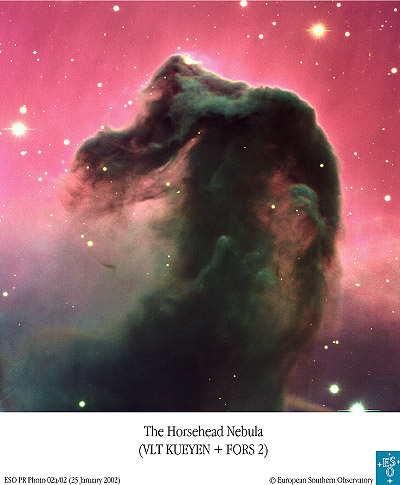







| BOOKS | F. A. Q. | ARTICLES | TALKS | ABOUT KEN | DONATE | BEYOND OUR KEN |
|---|
By Ken Croswell
January 31, 2006

Image by the European Southern Observatory's Very Large Telescope.
The Horsehead Nebula in Orion is rotating, say radio
astronomers in France, Holland, and Germany. The centrifugal
force the rotation has induced may account for the nebula's
distinctive shape.
Resembling a cosmic chess piece, the Horsehead is one of the most famous nebulae in the sky. It is a dark nebula that juts out from a much larger cloud. The Horsehead is made mostly of molecular hydrogen (H2), which is transparent, but dust particles blacken the gas so that it stands out against the magenta backdrop. The nebula is 1,300 light-years away.
Pierre Hily-Blant of the Institute of Millimeter Radio Astronomy in Saint Martin d'H�res, France; David Teyssier of the Space Research Organization Netherlands in Groningen; and Sabine Philipp and Rolf G�sten of the Max Planck Institute for Radio Astronomy in Bonn, Germany, say parts of this famous nebula are spinning. Using a 30-meter radio telescope in Spain, the astronomers studied the Horsehead Nebula's carbon monoxide (CO) gas. Although much rarer than molecular hydrogen, carbon monoxide readily emits radio waves.
Most carbon monoxide molecules contain the most common carbon and oxygen isotopes, carbon-12 and oxygen-16. However, Hily-Blant and his colleagues instead observed molecules having carbon-12 and oxygen-18, the heaviest stable isotope of oxygen. Because these molecules are rare, the astronomers detected them in the densest parts of the Horsehead. Thus, the observations probed the nebula's inner reaches.
The radio waves are Doppler shifted as different parts of the nebula move toward or away from us, producing either a blueshift or a redshift. The astronomers find that the horse's nose is turning toward us and part of the mane is turning away--as if the horse were trying to look in our direction. Furthermore, most of the horse's neck shares the same spin: the left (northern) side is approaching and the right (southern) side is receding. (In the image here, west is up and north is to the left.)
 The astronomers estimate that most of the neck will take
about 4 million years to spin once--if the nebula survives that
long. However, radiation from the hot blue star Sigma Orionis,
half a degree "above" (west of) the Horsehead, hits and erodes
the top of the nebula. As a result, astronomers think the
Horsehead, which is about half a million years old, will endure
for only another 5 million years. That's enough time to let the
nebula pirouette once before its demise.
The astronomers estimate that most of the neck will take
about 4 million years to spin once--if the nebula survives that
long. However, radiation from the hot blue star Sigma Orionis,
half a degree "above" (west of) the Horsehead, hits and erodes
the top of the nebula. As a result, astronomers think the
Horsehead, which is about half a million years old, will endure
for only another 5 million years. That's enough time to let the
nebula pirouette once before its demise.
"I think they did a great job," says Marc Pound of the University of Maryland at College Park, who has also studied the Horsehead but was not part of the discovery team. "It's a very interesting result. In one sense, it's surprising; in another sense, it's not. Lots of cores of clouds rotate, but the fact that the whole inner core of the Horsehead is rotating is quite unusual--because that's a very large structure." The Horsehead is two light-years long, half the distance from the Sun to Alpha Centauri. In contrast, Pound says the Eagle Nebula, which has a similar structure, is not rotating.
The Horsehead's rotation has sculpted the gas and dust into its unique shape, say Hily-Blant and his colleagues. The rotation has caused a centrifugal force that's flung what is now the horse's nose, on the left, and the mane, on the right, away from the neck, thereby giving the nebula its beautiful appearance. Without this rotation, the Horsehead Nebula probably wouldn't look like a horse--and its haunting figure might not grace the covers of so many books.
The astronomers are publishing their work in Astronomy and Astrophysics.
Ken Croswell is an astronomer and the author of Magnificent Universe and See the Stars: Your First Guide to the Night Sky.
"Magnificent Universe by Ken Croswell is elegant and eloquent."--Washington Post. See all reviews of Magnificent Universe here.
"Finally! An astronomy guide that the reader can actually follow without being a rocket scientist!" See all reviews of See the Stars here.
| BOOKS | F. A. Q. | ARTICLES | TALKS | ABOUT KEN | DONATE | BEYOND OUR KEN |
|---|